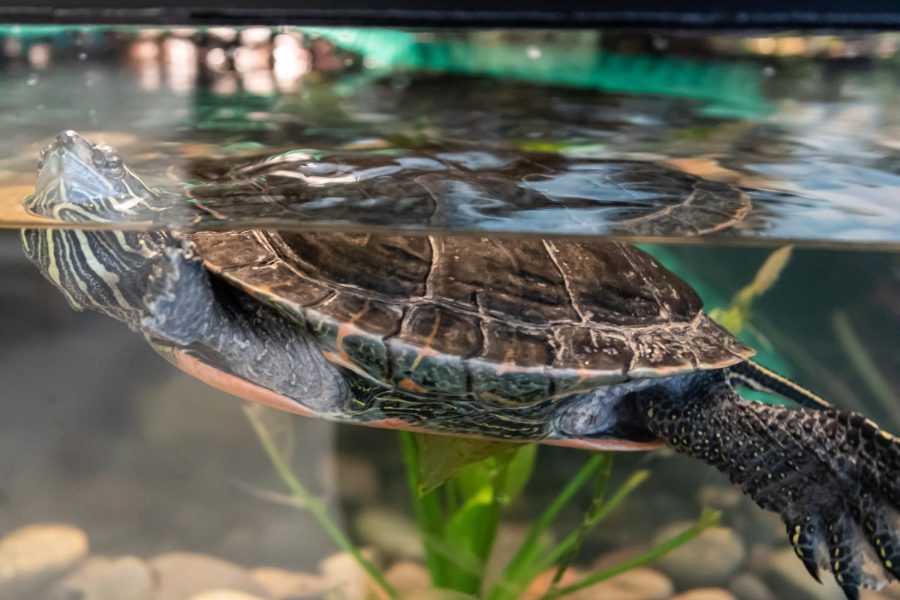Turtle begins career as educational ambassador at Veterinary Teaching Hospital
Bruce was kept as pet for five years, put in new enclosure two weeks ago; illegal to take animals from wild areas
Bruce’s aquarium in the VTH lobby has a rocky floor with four green plants, a rock platform above the water and a backdrop resembling a pond.
February 18, 2022
Bruce the turtle is now adjusting to a life of education in the WSU Veterinary Teaching Hospital lobby, after years in captivity.
Dr. Marcie Logsdon, VTH exotics veterinarian, said Bruce was found outside a pond a couple of miles away.
“Bruce was essentially going about normal turtle business until somebody saw her and decided that she would make a good pet,” Logsdon said. “Not only is that frowned upon from the turtle’s point of view, but it’s also illegal within the state of Washington to take wildlife and try to keep them as a pet.”
It is not uncommon for Western painted turtles to spend time out of water and travel several miles to get from one body of water to another, she said.
The VTH sees about two to three species of illegally captured animals a year, Logsdon said.
When illegal animals are brought in, usually the captors are unaware they are not allowed to take animals and keep them as pets, she said.
Bruce was brought to the VTH in 2018 after being kept as a pet for five years, and she was put into her new enclosure two weeks ago.
The first priority of the VTH’s exotics and wildlife program is to get animals back into the wild, Logsdon said.
Bruce is now used as an educational ambassador in the lobby of the VTH, Logsdon said. After consulting with the Washington Department of Fish and Wildlife and determining they should not release Bruce back in the wild, they transitioned to making her an ambassador.
Logsdon said there is educational information about Bruce’s species on a display board right next to her aquarium, along with outreach about why healthy wildlife should be left in their natural habitat.
Not all animals are fit to be an educational ambassador, but VTH staff decided she would be a very good fit because of her bubbly personality, Logsdon said.
VTH veterinary assistant Gail Collins has been working with Bruce for three years and feeds her on weekends. Bruce gets fed every day and gets her tank cleaned every two weeks.
Collins said Bruce’s diet consists of commercial turtle food and mealworms, but sometimes she is fed goldfish that she loves to chase around her enclosure.
“Bruce is very curious; she loves to swim and interact with the people in the lobby,” Collins said.
Since moving from her temporary enclosure to her educational aquarium, Bruce has been much more lively and interactive, Collins said.
Bruce’s aquarium has a rocky floor with four green plants, a rock platform above the water and a backdrop resembling a pond.
Collins said the backdrop is there not just for aesthetic purposes, but it also helps with Bruce’s comfortability. There is a heated rock above the water with heating lamps that she rests on to get warm.
Collins heavily stressed the importance of leaving wildlife wild and said the VTH line is open 24/7 for any and all wildlife inquiries.
Logsdon said Bruce is very loved by everyone at the hospital. However, she serves as an important reminder to not take animals from the wild. If you do see an injured or potentially harmed wild animal, reach out to a local wildlife rehabilitation center before interfering.









